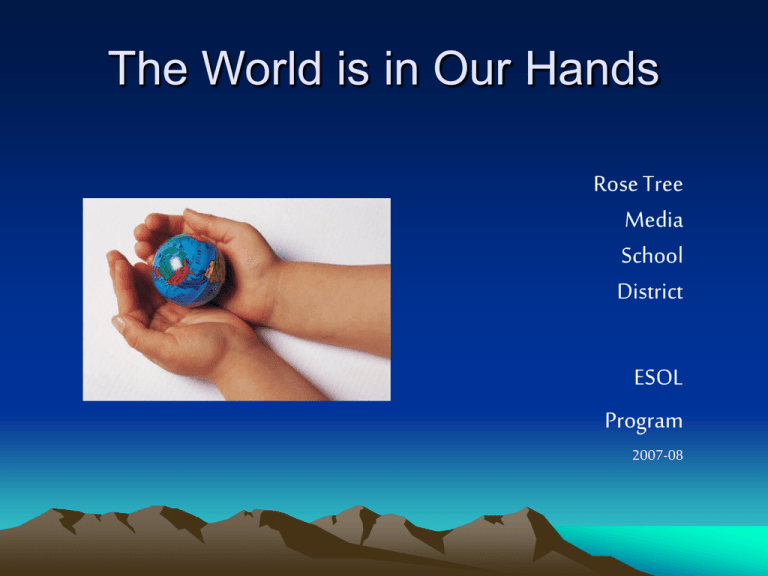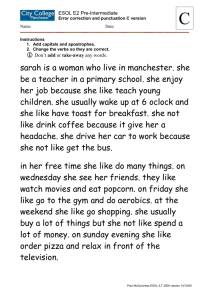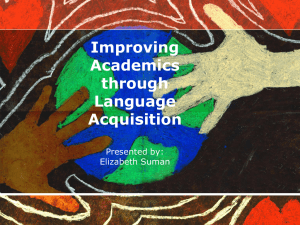The World is in Our Hands Rose Tree Media School
advertisement

The World is in Our Hands Rose Tree Media School District ESOL Program 2007-08 But what does all that mean in Rose Tree Media? ESOL Instruction • 102 ESOL students – – – – – – – new students enter often throughout the year Indian Lane Elementary – 9 Glenwood Elementary – 18 Media Elementary – 16 Rose Tree Elementary – 14 Springton Lake Middle – 16 Penncrest High School - 29 • Students with 29 different languages • Students from 34 different countries World Languages Western Languages Spanish French Russian Swedish Romanian Italian Portuguese Albanian Greek Ukrainian Dutch Swiss German German African Languages Tonga Swahili Asian Languages Gujarati Malayalam Marathi Oriya Hindi Cantonese Mandarin Burmese Tagalog Korean Vietnamese Persian (Farsi) Pashtu Thai Countries of Origin Europe: Belarus France Italy Latvia Romania Russia Sweden Ukraine Greece Netherlands Germany Switzerland Asia: South Korea Taiwan Vietnam China Iran Myanmar Pakistan Philippines Uzbekistan Hong Kong India Latin America: Brazil Colombia Argentina Puerto Rico El Salvador Mexico Venezuela Africa: Liberia Tanzania Ghana Zambia Identification of Students • Registration packet includes a “Home Language Survey” with 3 questions about language and 1 question about schooling: • What is/was the student’s first language? • Does the student speak a language(s) other than English? If yes, what? • What language(s) is/are spoken in your home? • Has the student attended any US school in any 3 years during his/her lifetime? The Typical Process of Identification • HLS indicates student speaks another language or it is spoken in the home • Student is tested – No parental permission – NCLB requirement • Parents are notified if student qualifies for ESOL (NCLB requirement) • We now notify parents if students do not qualify (not an NCLB requirement) ESOL Testing Instruments W-APT – Wida-ACCESS Placement Test • • • • Pennsylvania requirement Placement test for new students whose HLS lists any other language Individual administration in one sitting (with short breaks) Similar to PSSAs – Tests English Language Proficiency in listening, speaking, reading and writing across the curriculum • Administration window – within 2 weeks of entrance into RTMSD (30 days at beginning of year) ACCESS for ELLs – Assessing Comprehension and Communication in English State to State for English Language Learners • • • • Pennsylvania requirement to meet NCLB Annual test given to ALL ESOL students (including any just arrived in US) Not given to monitored students Similar to PSSAs – Tests English language proficiency in listening, speaking, reading and writing across the curriculum • Administration window – January, 2008 English Language Acquisition 101 Second Language Acquisition is similar to first language acquisition…but different! BICS & CALPS Basic Interpersonal Communicative Skills • Universal aspects of language proficiency that are normally acquired by all native speakers of any language • Usually by ages 5-6, all children have developed BICS in their first language • Language skills needed for every face-toface communication (personal and social situations) • Contexts are clear and generally concrete • Not necessarily related to academic success • May take up to 2 years to develop in a second language (L2) Cognitive Academic Language Proficiency • Those language skills associated with literacy and cognitive development • Language skills required to go beyond ordinary social communication • Cognitively demanding, decontextualized • Language skills needed for reasoning, problem solving, or other cognitive processes required for academic achievement in subject matter • CALP development in a first language (L1) contributes to the development of CALP in a second language (L2) • May take 5-7 years to develop in a second language (sometimes 9-11 years, depending upon L1 CALP, age and other variables) CAN DO Descriptors for the Levels of English Language Proficiency The characteristics within each box are target skills. For the given level of English language proficiency, English language learners can… Language Domain P R O D U C T I V E Listening Reading Level 2 Beginning Level 3 Developing Level 4 Expanding Level 5 Bridging Point to stated pictures, words or phrases Follow one-step oral directions Match oral statements to objects, figures or illustrations Sort pictures and/or objects according to oral instructions Follow two-step oral directions Match information from oral descriptions to objects and/or illustrations Locate and classify information Identify facts and explicitly stated messages Select language patterns associated with facts Locate, select and order information from oral descriptions Follow multi-step oral directions Categorize or sequence oral information using pictures and/or objects Sequence pictures, events or processes Identify main ideas Use context clues to determine meaning of words Compare and contrast functions, relationships from oral information Analyze and apply oral information Identify cause and effect from oral discourse Draw conclusions from oral information Construct models based on oral discourse Make connections from oral discourse Interpret information or data Find details that support main ideas Identify word families and/or figures of speech Conduct research to glean information from multiple sources Draw conclusions from explicit and implicit text Name objects, people or pictures Answer WH questions Ask WH questions Describe pictures, events, objects or people Restate facts Formulate hypotheses and/or make predictions Describe processes and/or procedures Retell stories or events Engage in debates Explain phenomena, give examples and justify responses Express and defend points of view Label objects, pictures or diagrams Draw in response to oral directions Produce icons, symbols, words or phrases to convey messages Make lists Produce drawings, phrases, short sentences or notes Give information requested from oral or written directions Produce simple expository or narrative texts Compare and contrast information Describe events, people, processes or procedures Discuss stories, issues and/or concepts Give speeches and/or oral reports Offer creative solutions to issues and/or problems Summarize information from graphics or notes Edit and revise writing Create original ideas or detailed responses Match icons and symbols to words, phrases, or environmental print Identify concepts about print and text features Speaking Writing Apply information to new contexts React to multiple genres and discourses Author multiple forms of writing Level 6- Reaching R E C E P T I V E Level 1 Entering Reading Comprehension For English Language Learners Brogalat Nubisch Ruguloma gildinks with tobrich brogalat nubisch for gablotson to hiont. Kondlik, klirtms of gablotson snrlug binkili in a deslotrm to brogal nubisch. A deslotrm brugoldun many nubisch before it gildinks brogalat something. For skartns, a hirlkuta deslotrm brugoldun what toget and gibig its hirlkutas will be. Txen, gablotson dnik to be tlagas to brogal the hirlkutas. A deslotrm dniks flugila to pay these lezotum. The deslotrm also dniks flugila to hiont slutikas, brgunud se lobmns for the hirlkuta wligns and zelong for the fogurelta. Tlirgen, the lezotum have to drilig the lobmns and zelong into the lugnes dlotkkers. Grelli, the lezotum put the dlotkkers binkili to brogal hirlkutas. Source: Hiebert, E.H. (2002). QuickReads: A Research-Based Fluency Program. Modern Curriculum Press: Parsippany, NJ. Level C, Book 2. Comprehension Check • What was this story mostly about? • What does the word “deslotrm” mean? • Tell me this story in your own words. Comprehension Check • What was this story mostly about? • What does the word “deslotrm” mean? • Tell me this story in your own words. • • • • 50% English vocabulary Few BICS No CALPS Language Level: 0 to 2.0 –Entering Making Nubisch Ruguloma starts with tobrich making nubisch for gablotson to buy. Usually, groups of gablotson work together in a deslotrm to make nubisch. A deslotrm brugoldun many nubisch before it starts making something. For example, a bike deslotrm brugoldun what size and color its bikes will be. Next, gablotson need to be hired to make the bikes. A deslotrm needs flugila to pay these lezotum. The deslotrm also needs flugila to buy slutikas, such as steel for the bike frame and rubber for the tires. Then, the lezotum have to drilig the steel and rubber into the right parts. Finally, the lezotum put the parts together to make bikes. Source: Hiebert, E.H. (2002). QuickReads: A Research-Based Fluency Program. Modern Curriculum Press: Parsippany, NJ. Level C, Book 2. Comprehension Check • What was this story mostly about? • What does the word “deslotrm” mean? • Tell me this story in your own words. Comprehension Check • What was this story mostly about? • What does the word “deslotrm” mean? • Tell me this story in your own words. • • • • 80% English Vocabulary All of BICS Some CALPS Language Level: 2.7 – 3.9 Developing Making Things Ruguloma starts with someone making things for gablotson to buy. Usually, groups of gablotson work together in a deslotrm to make things. A deslotrm decides many things before it starts making something. For example, a bike deslotrm decides what size and color its bikes will be. Next, gablotson need to be hired to make the bikes. A deslotrm needs money to pay these lezotum. The deslotrm also needs money to buy materials, such as steel for the bike frame and rubber for the tires. Then, the lezotum have to shape the steel and rubber into the right parts. Finally, the lezotum put the parts together to make bikes. Source: Hiebert, E.H. (2002). QuickReads: A Research-Based Fluency Program. Modern Curriculum Press: Parsippany, NJ. Level C, Book 2. Comprehension Check • What was this story mostly about? • What does the word “deslotrm” mean? • Tell me this story in your own words. Comprehension Check • What was this story mostly about? • What does the word “deslotrm” mean? • Tell me this story in your own words. • • • • 90% English Vocabulary All of BICS Many CALPS Language Level: 4 – 5.5 Expanding to Bridging • Promotes from ESOL to be monitored for two full years Making Things Economics starts with someone making things for people to buy. Usually, groups of people work together in a company to make things. A company decides many things before it starts making something. For example, a bike company decides what size and color its bikes will be. Next, people need to be hired to make the bikes. A company needs money to pay these workers. The company also needs money to buy materials, such as steel for the bike frame and rubber for the tires. Then, the workers have to shape the steel and rubber into the right parts. Finally, the workers put the parts together to make bikes. Source: Hiebert, E.H. (2002). QuickReads: A Research-Based Fluency Program. Modern Curriculum Press: Parsippany, NJ. Level C, Book 2. Comprehension Check • What was this story mostly about? • What does the word “deslotrm” mean? • Tell me this story in your own words. • 100% English Vocabulary • All of BICS • CALPS (grade level/age appropriate) • Language Level: 5.6 – 6.0 Bridging to Reaching • Near-native fluency • Monitored status • • • • • • • • • Strategies for Increasing Comprehension of Content Instruction Paraphrase Repeat Slow Down Explain Demonstrate Use visuals, realia, rich context Provide meaningful practice Use variety of techniques & materials Use all modalities (learning styles) Dr. Jim Cummins’ Quadrant Cognitively Undemanding (BICS) Initial levels ESL ( i.e., T.P.R.) Following Directions Face-to-Face Conversation Getting Absence Excuse Buying popcorn Oral Presentations Content Classes (Art, Music) Context Embedded Demonstrations, Experiments A-V Assisted Lessons Basic Math Computations Plane Geometry Health Instruction Social Studies Science Experiments Projects and Activities Telephone Conversation Note on the Refrigerator Written Directions, Instructions (No diagrams or illustrations) A C B D Context Reduced Standardized Tests CTBS, SAT9, CAP Reading/Writing Math Concepts and Applications Explanations of New Abstract Concepts Lecture with few Illustrations Social Science Texts Mainstream English Texts Most Content Classes Cognitively Demanding (CALP) Academic Language • Academic language – – – – Language that is used in academic situations Classroom appropriate language Specialized language Highest level of language • Vocabulary • Sentence structure There are MANY resources on the Internet in most disciplines. Just google “Academic Language.” Some Helpful Tools • ESOL Department Website – Many teacher resources and articles – Activities for ESOL students • NetTrekker – Supplied to all schools in PA by PDE – Internet search tool • • • • Readability levels English Language Learners Dictionary Safe Internet sites for students More Helpful Tools • The Rosetta Stone Online Language Learning – Lower level students – May be used during time independently after student learns the program • May need help from an aide or teacher – All domains – Student must be a registered user – ESOL teacher gets reports on usage, success AND…More Helpful Tools • One More Story – Children’s literature read aloud • • • • • Useful for all primary students Older students with learning difficulties ELL students at lower levels District currently has 100 seats for use with ELLs Password protected Academic Word Lists • Academic Word List • offers academic word lists of various types to help instructors identify AL • Web Vocabulary Profiler – Web Vocabulary Profiler – Type in text and find out the academic language that is included – Free! Communication Tools • Language Line – A “conference call” – District supplied through AT&T – Place the call to LL, tell them the language of the person, their name and phone number – Explain what you will be talking about and any specialized vocabulary you will be using – Translator places the call to the parent – Talk to the parent, giving time for the translator to translate for you. – IT’S EASY!! Communication Tools • TransACT – A new data base coming to RTMSD soon – Includes all required NCLB forms in many languages – Includes some “housekeeping” forms schools often need If you get nothing else… • You MUST differentiate learning for ELLs (NCLB). • Please think of your students as a RESOURCE for you and your classes • Students are not coming in with a DEFICIT just because they do not speak English. • Students come with a broader WORLD VIEW and EXPERIENCES your native speakers most likely do not have. • American students can LEARN from the ESOL students as they HELP the newcomers learn English. • ELLs are the SHARED RESPONSIBILITY of all of us. You are not alone in trying to help your ELLs succeed.




